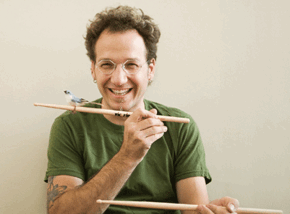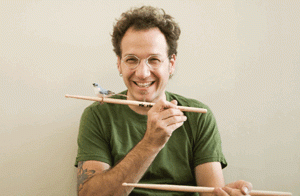Michael Morgan was scanning the score to Scott Amendola’s Fade to Orange the other day when he came across a big, dissonant block chord.

Related Articless
Oakland Symphony’s Heavenly Brahms Requiem
January 27, 2011
Oakland East Bay Symphony: Gold at 20
March 3, 2009
“It looks to me like a huge electric guitar chord sustained by the orchestra,” said Morgan, the musical director of the Oakland East Bay Symphony, who’s eager to hear what the piece actually sounds like when the orchestra rehearses it this week in preparation for its premiere Friday night at the Paramount Theatre.
Morgan commissioned the work from Amendola, the prized Bay Area drummer, composer, and bandleader whose open-ended music draws on jazz, rock, and experimental music, among other genres. It encompasses lyrical melodies and electronic noise, dancing grooves, floating textures, and free improvisation. Those elements come together in Fade to Orange, a 20-minute piece that features Amendola himself with two other protean improvisers playing off the orchestra and each other: electric bassist Trevor Dunn, and electric guitarist Nels Cline, a longtime Amendola collaborator best known for his work with the alternative rock band Wilco.
Written for his wife, Ari, Fade to Orange expresses Amendola’s feelings about love and falling in love. Orange is her favorite color, and the piece premieres on the couple’s anniversary. The title also refers to the sunsets — and the peaceful emotion they evoke — that Amendola often takes in as he drives west across the Bay Bridge to play gigs in San Francisco.
“It’s a very emotional piece,” he says. “It’s not complex. There aren’t a lot of fast lines. It’s very much about feeling these notes, feeling these chords, and building in intensity.” Writing this work, he adds, “has propelled me into something new as a composer. Certain aspects of my musical being came to light.”
Real-Time Sound Manipulation and Improvisation Come to the Symphony
“There’s a lot of back and forth between the trio and the orchestra,” says Amendola, who will play drums and percussion and will use electronic devices to capture and manipulate the sounds of the orchestra in real time. “The idea to is play back elements of what they’re doing and change it, with various delays, distortion, and reverb. I’m taking things that are going through the air and turning them into different sounds.”
Those effects are heard in the first section of this four-part piece, whose atmospheric opening suggests the sound of rain. The brass players are instructed to make valve noises and blow air through their horns without sounding pitches; the woodwinds will click their keys. Morgan assumes the strings will play pizzicato and tap the bodies of their instruments.
That’s one of two spots in Fade to Orange where orchestra musicians are asked to improvise. The other comes at the end of the third section, where interweaving, syncopated melodies, riding in a kind of Afro-Brazilian groove, lead to some roof-rattling passages that might be called heavy-metal Stravinsky. The musicians improvise a patch of noise that goes from triple fortissimo to triple pianissimo in 60 seconds.
“Some of the less-improvised sections tend to be lush and romantic, with melodies in counterpoint to each other or in canon,” says Morgan, who describes Amendola as “someone who hears a lot of different music and brings it all into what he does. He’s very much about pulling all these various things together. He’s creating something new that’s greater than the sum of its parts.”
On-the-Job Training
Amendola, a New Jersey native who studied at Boston’s Berklee College of Music, has been a vital presence on the Bay Area’s creative, improvised music scene since the early 1990s. He’s written a good deal of music for small ensembles, including his bands featuring the noted violinist Jenny Scheinman. Yet he’d never written for symphony orchestra until he landed this commission.
“It was very challenging, exciting, and daunting,” says Amendola, on the phone from New York. He’d just arrived there after touring Europe with the celebrated seven-string guitarist Charlie Hunter, with whom the drummer performed in the popular genre-crossing quartet TJ Kirk. (Amendola’s other notable associates include jazz guitarists Bill Frisell and Pat Martino and the avant-garde saxophonist and composer John Zorn.)
For this project, he received guidance and technical help from composer Elinor Armer. Among other suggestions, she advised him against spontaneously cueing orchestral parts — there wouldn’t be enough rehearsal time to work out the communication — and helped him to convey the rubato feeling he was after in passages where the pulse isn’t pronounced. She also suggested that he read Henry Mancini’s orchestration book, which he bought but never read. After seeing his rough sketches, she told him to forget the book and keep doing his own thing.
Amendola began the piece with a cyclical chordal pattern that came to him one day at the piano. As other ideas emerged, he jotted down words and notes on score paper he’d affixed to the walls of his Berkeley home.
“I started piecing together ideas. It was like a puzzle, in a way,” says the composer, who listened to Ligeti’s Atmospheres, the Bartók Piano Concertos, and Peter Gabriel’s orchestral record Scratch My Back, among other things, around the time he composed the piece.
Amendola says he was thrilled to get the chance to write for strings and have all the colors of the orchestra at his disposal. He scored parts for celeste, marimba, tubular bells, and timpani, as well as call-and-response figures between woodwinds and strings, plus tubas, basses, and trombones. He himself shapes and colors the sound when the orchestra is grooving, and takes a brief drum solo, played on brushes, in the quiet, spacious final section given over to the strings.
Fresh Takes From Beyond the Orchestral World
Fade to Orange is the last of four new works brought forth over the past two seasons by the OEBS’ New Visions/New Vistas Commission Project. The great rock guitarist Carlos Santana was featured in a commissioned work by Narada Michael Walden last fall. Earlier last year, the Symphony premiered Rebeca Mauleón’s Suite Afro-Cubano, which merged flamenco, mambo, and Ravel.
“An important part of the project is that the orchestra and I learn something along the way,’’ says Morgan, who placed Fade to Orange on the “Height of Romanticism” program with Tchaikovsky’s Symphony No. 4 and Bernard Herrmann’s Suite from Vertigo.
“What I always try to do with the programming of this orchestra is to juxtapose something standard like the Tchaikovsky with a new piece like this. You start to hear everything differently. You start to hear the connectedness between the old music and the new music. A symphony orchestra should be a living, breathing place, where the stuff that’s 200 years old has a connection to the stuff that was written last year.”
Amendola, who talks about bridging musical gaps, agrees.
“Bringing someone like me in to work with these musicians opens the door for us to realize we have a lot in common,” says the composer, who can’t wait for Wednesday’s rehearsal.
“I don’t know how it’s going to sound,” Amendola says cheerfully. “It should be fine. I think we’re all going to have a really good time.”

